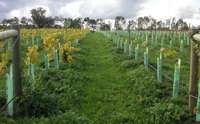A tool to help growers and nurseries plant healthier grape vines has been developed by a Charles Sturt University (CSU) researcher.
CSU PhD student Ms Helen Waite has developed the risk assessment tool for reducing trunk diseases in grapevine cuttings as part of her research through the National Wine and Grape Indistry Centre in Wagga Wagga.
"Unhealthy vines are less productive, they produce poorer quality fruit, they're harder to manage and therefore they cost a lot more money so it can sometimes threaten the sustainability of a vineyard," she said.
"It costs from $30,000 to $50,000 to plant a hectare of vines and sometimes people don't consider what they're buying other than the variety and type of root-stock. It's only when the vines don't grow well or fail within two years that they start to think about the quality of the planting material, but of course by then it has cost them a lot of time and money."
Ms Waite said hot water treatment is effective in reducing the spread of trunk diseases in grape-vine cuttings but it can cause stress on the plant.
"Nurseries are a bit wary of using hot water treatment because there have been some failures in the past which have been attributed to the stress that it causes the plant. What I'm doing is looking at a system for grape vine propagation that can use hot water safely," she said.
The research has identified that handling and storage of the cuttings before and after the hot water treatment is crucial.
"If we put them straight into cold storage in sealed plastic bags after treatment it basically suffocates the plant," said Ms Waite.
"It's also got to do with how far into the winter they are treated; if it's close to spring and they have started to come out of dormancy then the cuttings are much more susceptible to damage in hot water treatment." The healthy grapevines on the left compared with diseased vines on the right
Ms Waite has developed a risk assessment spreadsheet, with the help of Mr Ken Appleby, which should give grape growers more information about what they're planting.
"The grower can open the package, look at the bundle of vines, use the assessment criteria to get a score, then sample some vines, peeling the bark off and dissecting the vines to look for disease," she said. "That combined with an examination of the paperwork will give an overall score of the risk of planting that material."
The research has led to the development a set of guidelines for hot water treatment for cuttings which is being trialled in an Australian nursery this year.
"It's difficult to change practises at a time when they're not selling much product due to the down-turn in the wine industry but there has been a new willingness on the part of the nurseries, and the vine improvement schemes who supply the cuttings, to change what they are doing to ensure there's a better product coming out of the system," she said.
Provided by Charles Sturt University




















